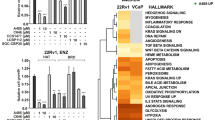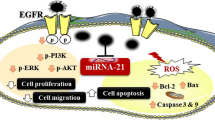Abstract
EP4 is one of the prostaglandin E2 receptors, which is the most common prostanoid and is associated with inflammatory disease and cancer. We previously reported that over-expression of EP4 was one of the mechanisms responsible for progression to castration-resistant prostate cancer, and an EP4 antagonist ONO-AE3-208 in vivo suppressed the castration-resistant progression regulating the activation of androgen receptor. The aim of this study was to analyze the association of EP4 with prostate cancer metastasis and the efficacy of ONO-AE3-208 for suppressing the metastasis. The expression levels of EP4 mRNA were evaluated in prostate cancer cell lines, LNCaP, and PC3. EP4 over-expressing LNCaP was established, and their cell invasiveness was compared with the control LNCaP (LNCaP/mock). The in vitro cell proliferation, invasion, and migration of these cells were examined under different concentrations of ONO-AE3-208. An in vivo bone metastatic mouse model was constructed by inoculating luciferase expressing PC3 cells into left ventricle of nude mice. Their bone metastasis was observed by bioluminescent imaging with or without ONO-AE3-208 administration. The EP4 mRNA expression levels were higher in PC3 than in LNCaP, and EP4 over-expression of LNCaP cells enhanced their cell invasiveness. The in vitro cell invasion and migration were suppressed by ONO-AE3-208 in a dose-dependent manner without affecting cell proliferation. The in vivo bone metastasis of PC3 was also suppressed by ONO-AE3-208 treatment. EP4 expression levels were correlated with prostate cancer cell invasiveness and EP4 specific antagonist ONO-AE3-208 suppressed cell invasion, migration, and bone metastasis, indicating that it is a potential novel therapeutic modality for the treatment of metastatic prostate cancer.




Similar content being viewed by others
References
Gronberg, H. (2003). Prostate cancer epidemiology. Lancet, 261, 859.
Siegel, R., Naishadham, D., & Jemal, A. (2012). Cancer statistics, 2012. CA: A Cancer Journal for Clinicians, 62, 10.
Terada, N., Shimizu, Y., Kamba, T., et al. (2010). Identification of EP4 as a potential target for the treatment of castration-resistant prostate cancer using a novel xenograft model. Cancer Research, 70, 1606.
Xin, X., Majumder, M., Girish, G. V., et al. (2012). Targeting COX-2 and EP4 to control tumor growth, angiogenesis, lymphangiogenesis and metastasis to the lungs and lymph nodes in a breast cancer model. Laboratory Investigation, 92, 1115.
Takita, M., Inada, M., Maruyama, T., et al. (2007). Prostaglandin E receptor EP4 antagonist suppresses osteolysis due to bone metastasis of mouse malignant melanoma cells. FEBS Letters, 581, 565.
Karavitis, J., Hix, L. M., Shi, Y. H., et al. (2012). Regulation of COX2 expression in mouse mammary tumor cells controls bone metastasis and PGE2-induction of regulatory T cell migration. PLoS One, 7, e46342.
Xing, N. D., Ding, S. T., Saito, R., et al. (2011). A potent chemotherapeutic strategy in prostate cancer: S-(methoxytrityl)-l-cysteine, a novel Eg5 inhibitor. Asian Journal of Andrology, 13, 236.
Kabashima, K., Sakata, D., Nagamachi, M., et al. (2003). Prostaglandin E2-EP4 signaling initiates skin immune responses by promoting migration and maturation of Langerhans cells. Nature Medicine, 9, 744.
Saito, R., Shirakawa, R., Nishiyama, H., et al. (2013). Downregulation of Ral GTPase-activating protein promotes tumor invasion and metastasis of bladder cancer. Oncogene, 32, 894.
Wu, T. T., Sikes, R. A., Cui, Q., et al. (1998). Establishing human prostate cancer cell xenografts in bone: induction of osteoblastic reaction by prostate-specific antigen-producing tumors in athymic and SCID/bg mice using LNCaP and lineage-derived metastatic sublines. International Journal of Cancer, 77, 887.
Platz, E. A., De Marzo, A. M. (2004). Epidemiology of inflammation and prostate cancer. Journal of Urology, 171, S36.
De Marzo, A. M., Platz, E. A., Sutcliffe, S., et al. (2007). Inflammation in prostate carcinogenesis. Nature Reviews Cancer, 7, 256.
Veitonmäki, T., Tammela, T. L., Auvinen, A., et al. (2013). Use of aspirin, but not other non-steroidal anti-inflammatory drugs is associated with decreased prostate cancer risk at the population level. European Journal of Cancer, 49, 938.
Abedinpour, P., Baron, V. T., Welsh, J., et al. (2011). Regression of prostate tumors upon combination of hormone ablation therapy and celecoxib in vivo. Prostate, 71, 813.
Katkoori, V. R., Manne, K., Vital-Reyes, V. S., et al. (2013). Selective COX-2 inhibitor (celecoxib) decreases cellular growth in prostate cancer cell lines independent of p53. Biotechnic and Histochemistry, 88, 38.
Ray, W. A., Stein, C. M., Daugherty, J. R., et al. (2002). COX-2 selective non-steroidal anti-inflammatory drugs and risk of serious coronary heart disease. Lancet, 360, 1071.
Ma, X., Kundu, N., Rifat, S., Walser, T., et al. (2006). Prostaglandin E receptor EP4 antagonism inhibits breast cancer metastasis. Cancer Research, 66, 2923.
Mutoh, M., Watanabe, K., Kitamura, T., et al. (2002). Involvement of prostaglandin E receptor subtype EP(4) in colon carcinogenesis. Cancer Research, 62, 28.
Kim, J. I., Lakshmikanthan, V., Frilot, N., et al. (2010). Prostaglandin E2 promotes lung cancer cell migration via EP4-betaArrestin1-c-Src signalsome. Molecular Cancer Research, 8, 569.
Rundhaug, J. E., Simper, M. S., Surh, I., et al. (2011). The role of the EP receptors for prostaglandin E2 in skin and skin cancer. Cancer and Metastasis Reviews, 30, 465.
Wu, J., Zhang, Y., Frilot, N., et al. (2011). Prostaglandin E2 regulates renal cell carcinoma invasion through the EP4 receptor-Rap GTPase signal transduction pathway. Journal of Biological Chemistry, 286, 33954.
Huang, H. F., Shu, P., Murphy, T. F., et al. (2013). Significance of divergent expression of prostaglandin EP4 and EP3 receptors in human prostate cancer. Molecular Cancer Research, 11, 427.
Kabashima, K., Sakata, D., Nagamachi, M., et al. (2003). Prostaglandin E2-EP4 signaling initiates skin immune responses by promoting migration and maturation of Langerhans cells. Nature Medicine, 9, 744.
Yang, L., Huang, Y., Porta, R., et al. (2006). Host and direct antitumor effects and profound reduction in tumor metastasis with selective EP4 receptor antagonism. Cancer Research, 66, 9665.
Acknowledgments
We thank Tahaniro Inoue, Tomomi Kamba, and Koji Yoshimura for their helpful discussion and Miyuki Ono for her valuable technical assistance.
Author information
Authors and Affiliations
Corresponding author
Additional information
Song Xu and Zhengyu Zhang contributed equally to this work.
Rights and permissions
About this article
Cite this article
Xu, S., Zhang, Z., Ogawa, O. et al. An EP4 Antagonist ONO-AE3-208 Suppresses Cell Invasion, Migration, and Metastasis of Prostate Cancer. Cell Biochem Biophys 70, 521–527 (2014). https://doi.org/10.1007/s12013-014-9951-2
Published:
Issue Date:
DOI: https://doi.org/10.1007/s12013-014-9951-2




